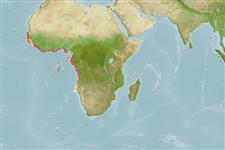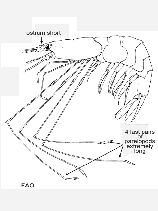Nematocarcinus africanus Crosnier & Forest, 1973
African spider shrimp| Native range | All suitable habitat | Point map | Year 2050 |

|
| This map was computer-generated and has not yet been reviewed. |
| Nematocarcinus africanus AquaMaps Data sources: GBIF OBIS |
Mandar um arquivo com seu (sua) Fotos
| Todas as fotos | Imagem do Google | Nematocarcinus africanus
| Todas as fotos | Imagem do Google | Nematocarcinus africanus
Classification / Names Common names | Synonyms | CoL | ITIS | WoRMS
| Decapoda | Nematocarcinidae
Environment: milieu / climate zone / depth range / distribution range Ecologia
; intervalo de profundidade 200 - 755 m (Ref. 434), usually 300 - 600 m (Ref. 434). Tropical; 5°C - 12°C (Ref. 434); 16°N - 20°S, 18°W - 14°E
Distribuição Países | Áreas FAO | Ecossistemas | Ocorrências | Introduções
Eastern Atlantic: from Senegal to Namibia.
Length at first maturity / Tamanho / Peso / Idade
Maturity: Lm ? range ? - ? cm Max length : 10.4 cm TL macho/indeterminado; (Ref. 434)
Maximum depth from Ref. 104448. Exclusively occurs in deep-sea, living in soft mud deep sea bottom (Ref. 98500). Predominantly benthic species inhabiting only muddy bottoms in cold waters (5-12°C). Vertical distribution varies in size, older individuals occur in deeper depth range from 200 to 700 m, most abundant between 300 and 600 m (Ref. 434). Key functional intermediate between decaying organic matter and larger invertebrates and fish (Ref. 107108).
Life cycle and mating behavior Maturidade | Reprodução | Desova | Ovos | Fecundidade | Larvas
Members of the order Decapoda are mostly gonochoric. Mating behavior: Precopulatory courtship ritual is common (through olfactory and tactile cues); usually indirect sperm transfer.
Referência principal
Referências | Coordenador | Colaboradores
Fischer, W., G. Bianchi and W.B. Scott (eds.). 1981. (Ref. 434)
Status na Lista Vermelha da IUCN (Ref. 130435)
Status no CITES (Ref. 108899)
Not Evaluated
CMS (Ref. 116361)
Not Evaluated
Perigo para os humanos
Uso pelos humanos
Pescarias: espécies comerciais
| FishSource |
Ferramentas
Mais informação
Fontes da internet
BHL | BOLD Systems | CISTI | DiscoverLife | FAO(Publication : search) | Fishipedia | GenBank (genoma, nucleotídeo) | GloBI | Gomexsi | Google Books | Google Scholar | Google | PubMed | Árvore da vida | Wikipedia (Ir para, procura) | Registro zoológico
Estimates based on models
Preferred temperature
(Ref. 115969): 6.3 - 11, mean 8.8 (based on 29 cells).
Categoria de preço
(Ref. 80766):
Unknown.



